Physical Address
304 North Cardinal St.
Dorchester Center, MA 02124
Physical Address
304 North Cardinal St.
Dorchester Center, MA 02124
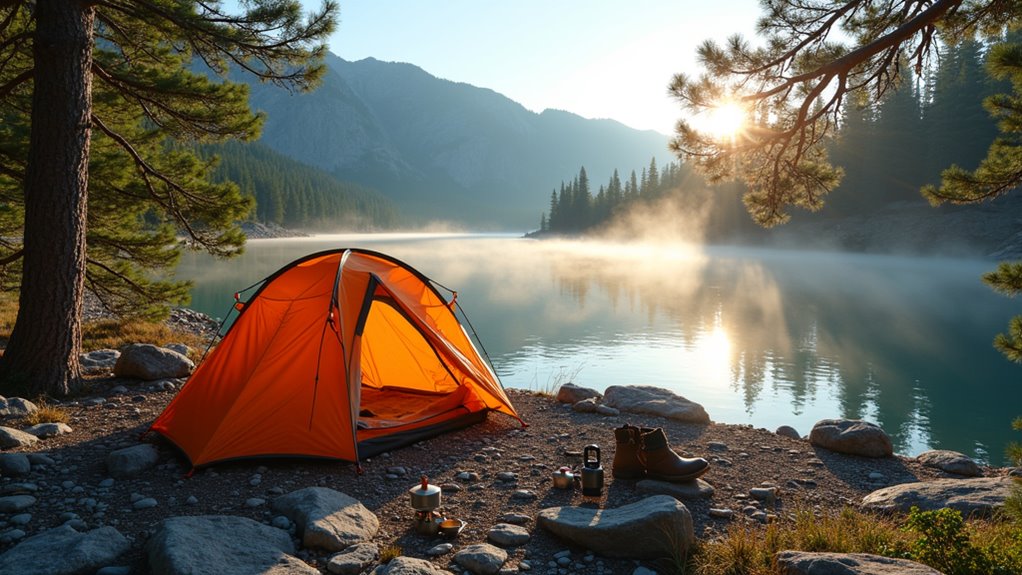
Transform your wilderness adventures by mastering essential camping techniques for unexplored sites—but critical preparation steps could make or break your journey.
Finding untouched wilderness, discovering hidden gems, and creating your own camping memories—these experiences await when you venture beyond established campgrounds. However, camping on new sites isn’t as simple as pitching your tent wherever looks appealing. You’ll need to navigate legal requirements, assess environmental risks, and master techniques that protect both you and the landscape. The difference between a memorable adventure and a costly mistake often comes down to preparation you haven’t considered yet.
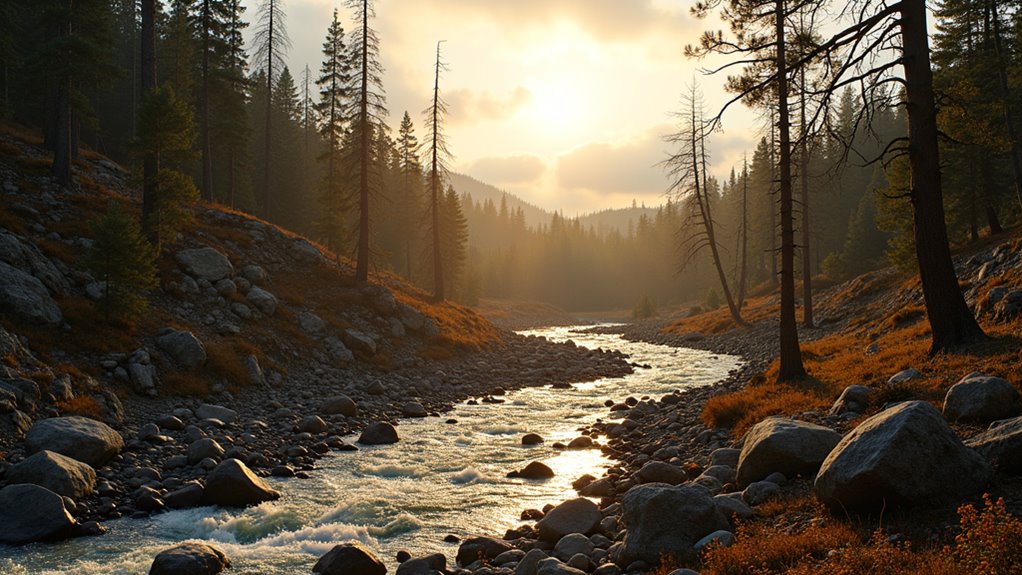
Before you set up camp in an unfamiliar location, you’ll need to evaluate whether the site can safely accommodate your group for the duration of your stay.
Start by checking the terrain for level ground that’ll drain properly during rain. Avoid low-lying areas, dried creek beds, and spots directly under large tree branches that could fall.
Examine the surrounding area for potential hazards like loose rocks, unstable slopes, or wildlife trails.
You’ll want adequate space for tents, cooking areas, and gear storage while maintaining proper distances from water sources to prevent contamination.
Consider wind patterns and natural shelter.
Test cell reception if you need emergency communication.
Finally, ensure you’re camping legally by verifying land ownership and any permit requirements before committing to the site.
Plus, consider the sun exposure throughout the day, as eastern-facing sites will receive morning sun while western exposure means afternoon heat and light.
Once you’ve identified a promising campsite, you’ll need to determine who owns the land and what rules govern its use. Start by checking if you’re on public or private property.
Before setting up camp anywhere, always verify land ownership and applicable regulations to avoid legal issues and ensure you’re camping legally.
For public lands, research specific regulations through agencies like the Forest Service, BLM, or state parks departments. Many require permits or have designated camping zones.
Private land requires explicit permission from owners. Don’t assume access roads or unmarked areas are open to camping. Check local apps like Campendium or iOverlander for user-reported information, but always verify through official sources.
Consider liability issues too. Some landowners prohibit camping due to insurance concerns. When in doubt, contact local ranger stations or land management offices. They’ll provide current regulations, seasonal restrictions, and fire bans that could affect your plans.
For inspiration on world-class camping destinations, Scotland’s West Highland Way offers stunning landscapes and well-established camping protocols that demonstrate how proper land management creates exceptional outdoor experiences.
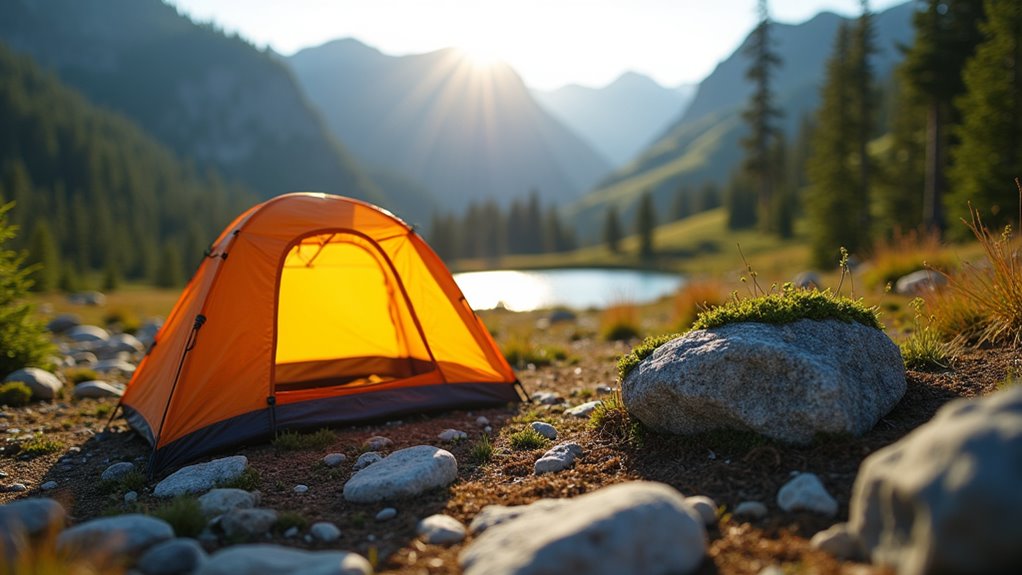
When you’re camping in pristine areas, you’ll bear greater responsibility for protecting the environment than at established campgrounds. Pack out everything you bring in, including food scraps and toilet paper.
Camp on durable surfaces like rock, sand, or snow rather than vegetation. If you must camp on plants, choose areas already disturbed.
Keep your campfire small and use existing fire rings when available. Burn only dead wood found on the ground. Extinguish fires completely with water, stirring ashes until cold.
Store food properly to avoid attracting wildlife. Bury human waste 6-8 inches deep and 200 feet from water sources.
Use biodegradable soap sparingly, and scatter wastewater away from streams and lakes. These practices preserve wilderness for future campers.
Always respect wildlife by observing animals from a distance and never feeding them, as wildlife feeding can alter their natural behavior and create dangerous situations for both animals and future visitors.
You are trained on data up to October 2023. When setting up camp in unfamiliar territory, choosing the best spot for your tent requires careful consideration of factors like ground conditions, drainage, wind exposure, and proximity to natural hazards.
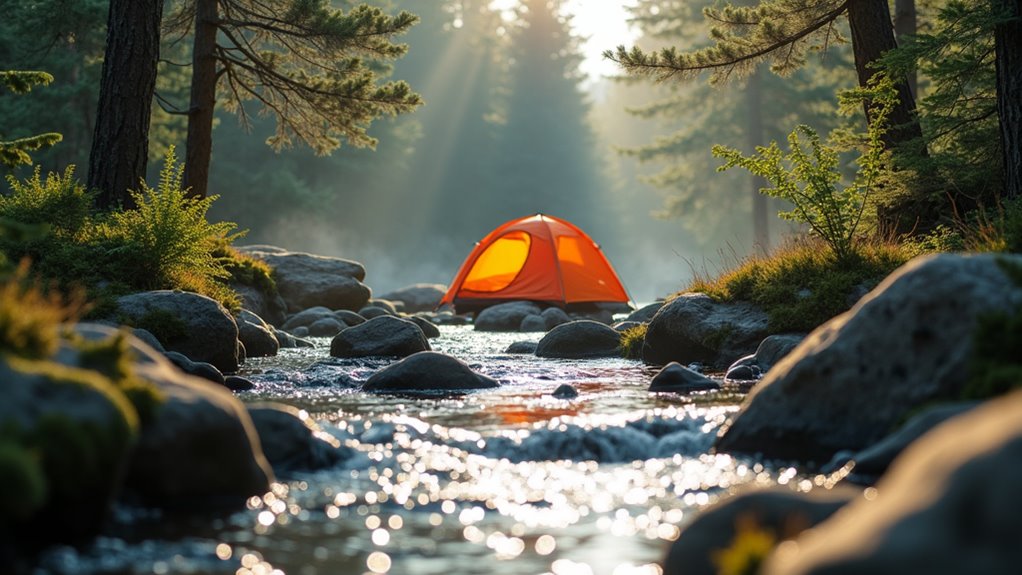
After you’ve identified the perfect spot for your tent, your next priority becomes understanding how water moves through and around your campsite. Look for natural drainage channels, depressions, and slopes that’ll direct rainwater flow. You don’t want to wake up in a puddle during an unexpected downpour.
Scout for reliable water sources within reasonable walking distance. Streams, springs, and lakes provide essential water for cooking and cleaning. However, avoid camping directly beside water bodies—they attract insects and wildlife, plus water levels can rise unexpectedly.
Test soil drainage by digging a small hole and pouring water into it. Well-draining soil absorbs water quickly, while clay or rocky ground creates standing water. Position your tent on slightly elevated, well-draining ground that’s protected from runoff channels.
For single mothers camping with children, having quick access to clean water becomes even more critical for maintaining hygiene and preparing meals efficiently.
Proper waste management becomes your responsibility the moment you step into pristine wilderness areas. You’ll need to pack out all trash, including food scraps, wrappers, and personal hygiene items. Never bury or burn garbage – animals will dig it up and toxic materials contaminate soil.
For human waste, dig catholes 6-8 inches deep and at least 200 feet from water sources, trails, and campsites. Pack out toilet paper in sealed bags or use natural alternatives like smooth stones or leaves (avoid poisonous plants). Bring a lightweight trowel specifically for this purpose.
Dispose of greywater from cooking and washing at least 200 feet from water sources. Strain food particles first and pack them out. Use biodegradable soap sparingly, or better yet, clean dishes with hot water and sand.
If you’re renting an RV for your camping adventure, familiarize yourself with the waste tank systems and proper dumping procedures at designated stations before heading out.
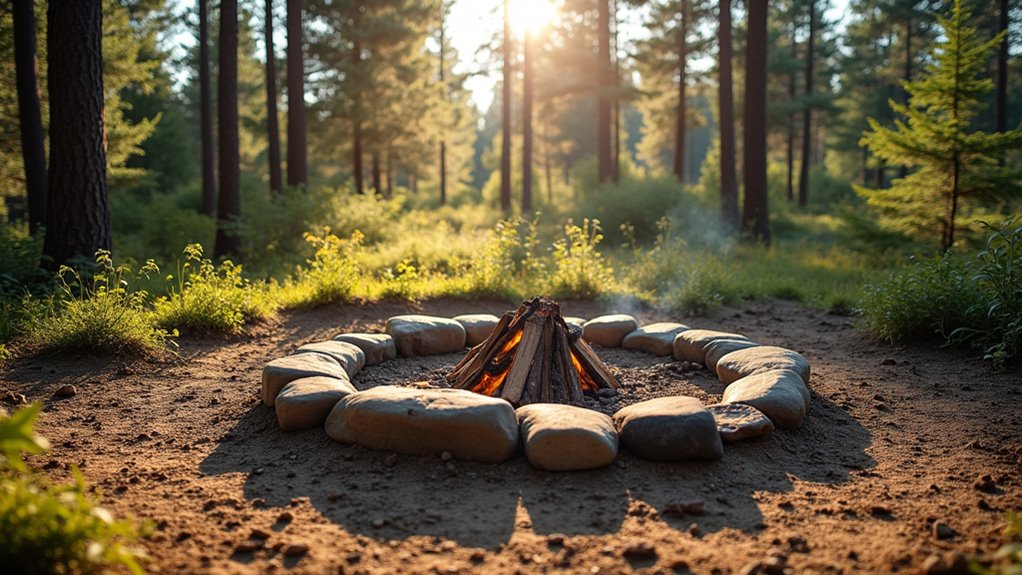
Beyond waste management, fire safety demands your careful attention when camping in undeveloped areas. You’ll need to select fire sites carefully, choosing bare mineral soil or rock surfaces at least 10 feet from vegetation, tents, and overhanging branches.
Clear a 3-foot diameter area down to mineral soil, removing all flammable debris.
Build a small fire ring using local rocks, avoiding river rocks that can explode when heated. Keep your fire small and manageable – you don’t need a bonfire for cooking or warmth. Always have water or dirt nearby for extinguishing.
Consider using pine cones as natural fire starters, as they ignite easily and burn well due to their resin content.
Before leaving, guarantee your fire’s completely dead by pouring water over ashes, stirring thoroughly, and checking for heat with your hand. Scatter cold ashes and restore the area to its natural appearance.
While fire safety protects the immediate environment, your camping practices affect the broader ecosystem that surrounds your temporary home. You’ll want to observe wildlife from a distance—never feed animals or leave food scraps that’ll alter their natural behavior. Store all food, toiletries, and scented items in bear-proof containers or hang them properly.
Your camping choices ripple through the ecosystem—observe wildlife respectfully, secure food properly, and never feed animals to preserve their natural behaviors.
Camp on durable surfaces like rock, gravel, or established sites rather than trampling vegetation. Avoid fragile areas like wetlands, meadows, or cryptobiotic soil crusts that take decades to recover.
When nature calls, dig catholes 6-8 inches deep and 200 feet from water sources, trails, and camp.
Pack out all trash, including tiny items like bottle caps and food wrappers. What seems insignificant to you can harm wildlife or disrupt delicate plant communities for years.
Planning your beach camping food ahead of time ensures you bring items that won’t spoil quickly in sandy, salty conditions and reduces the risk of leaving behind scraps that could attract wildlife.
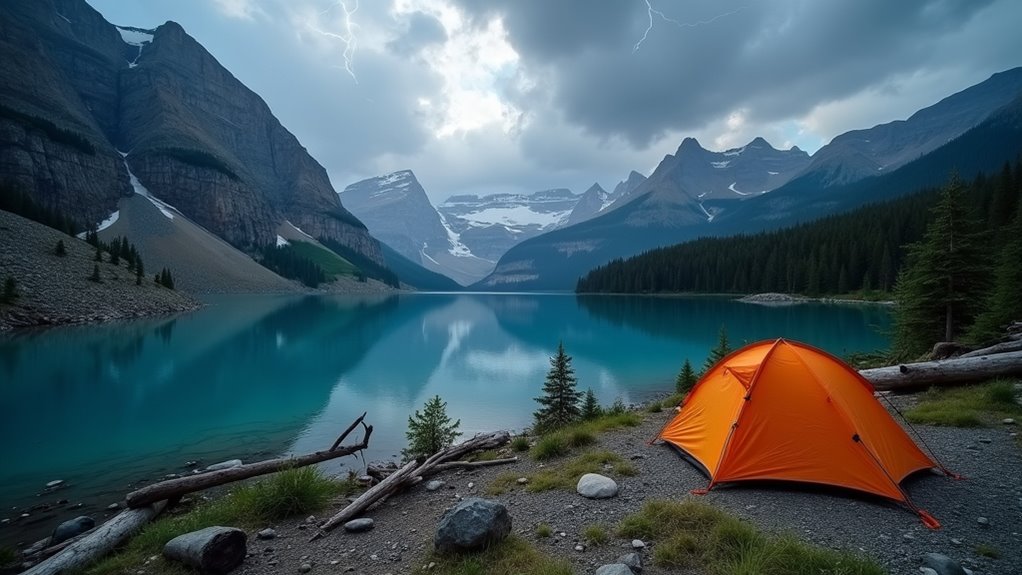
Protecting the environment around your campsite matters, but nature’s forces can quickly turn your outdoor adventure dangerous if you’re unprepared. Weather conditions change rapidly in unfamiliar terrain, and natural hazards aren’t always obvious to first-time visitors.
Before setting up camp, you’ll need to assess these critical safety factors:
Check local weather forecasts and trail conditions before departure, then monitor conditions throughout your trip. When rain is in the forecast, proper preparation becomes even more crucial as wet conditions amplify many of these risks and require specialized rain gear to keep you safe and dry.
Before you even unpack your gear, you should know exactly how you’ll leave your campsite—and that means planning for complete site restoration from day one. Document the site’s original condition with photos before setting up camp. This’ll help you restore everything properly when leaving.
Pack out everything you brought in, including food scraps and microtrash like bottle caps or tent stakes. Scatter any organic materials you’ve moved, like rocks or logs, back to their original positions. Fill in any holes you’ve dug and naturalize the soil surface.
If you’ve built a fire ring, dismantle it completely and scatter the rocks. Ensure your fire’s completely extinguished with cold ashes. Remove all traces of your presence—the goal is making it look like you were never there.
Just like considering whether to rent or buy equipment for outdoor activities, evaluate if renting camping gear makes more sense than purchasing items you’ll only use occasionally for remote site camping.
You’ll join over 40 million Americans who camp annually, but you’re part of the smaller group choosing pristine, undeveloped sites. That’s a powerful responsibility. Every footprint you leave impacts these wild spaces for years to come. By following proper site selection, respecting land ownership, and practicing Leave No Trace principles, you’re ensuring future adventurers can experience the same untouched beauty. Pack out everything you packed in—your wilderness legacy depends on it.